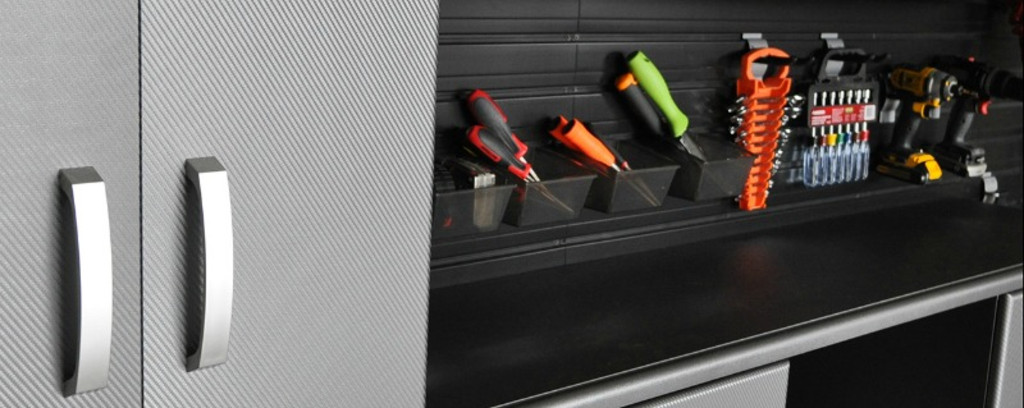Now more than ever, garages have become extensions of our main living spaces. They provide adequate shelter from outdoor elements and are the perfect place to work on projects long after the sun goes down. The only problem, however, is that garage lighting isn't always adequate and can cause a variety of frustrations. To help you illuminate your garage the right way, here are a few garage lighting tips and ideas on how to achieve better lighting and improve the overall quality of your garage workspace.
Type of Light
Artificial lighting falls into one of three categories—ambient, task, and accent—and you'll want all forms for optimal indoor garage lighting.
Ambient lighting is soft overhead light used to illuminate the floors and walls so you can safely get around or park your car without putting a hole in the wall.
Task lighting is brighter, intended for work and storage areas to lend increased visibility during detail-oriented projects and organizational tasks like that project you were super excited about and started last year but never finished (you know the one).
Accent lighting, in between ambient and task lighting in brightness, shines on showpieces you want to emphasize, be it a foosball table or an old trophy collection of that bobblehead you got from your wife.
There are 3 types of bulbs that you can incorporate into your indoor garage lighting plan. You may want to pick one to use for all your lighting, or you can mix and match to fit your needs and get the right lighting in the right space.
Fluorescent Light Fixtures
If you're looking to light up your entire garage, fluorescent lights may be your answer. Fluorescent light fixtures are inexpensive and the bulbs give off enough light so you are able to see true colors while you work. They are also easy to install and can be positioned and mounted over your existing ceiling light boxes. One drawback to fluorescent lighting is that the bulbs don't always like to work in cold weather. However, you can purchase fixtures based on temperatures. Magnetic ballasts are fine if your garage never drops below 50 degrees Fahrenheit. If you plan on working in more frigid temperatures, make sure to buy fixtures with electronic ballasts. The electronic ballasts are fully functional down to 0 degrees and lower. making them one of the best garage lights for cold weather. If you want to go the more energy efficient route, we suggest you purchase the 1-inch-wide T8 lamps as the energy-saver T12 lamps only work at 60 degrees F or higher. For more information on fluorescent lighting, check out this guide.
Incandescent Lighting
If you're working in a designated area of your garage, like a work table, incandescent lighting is a great option. Incandescent lights, like halogens and xenon bulbs, give off a more focused light that is bright and perfect for meticulous projects. While halogens are the brightest bulbs available, they also generate heat. If your lighting is mounted under a cabinet just above your work table, you may want to consider buying low voltage bulbs. Xenon bulbs are another great option as they also provide about the same bright light, but without the heat.
LED Bulbs
If you aren't looking to add new fixtures to your garage, but still want to improve garage lighting, LED bulbs are another great option. The best thing about LEDs is that they last a very long time‚ often 20 to 30 years. So if your garage is poorly lit because you don't want to climb a ladder to keep changing your bulbs, this is the perfect solution. In fact, it's a perfect option for any hard-to-reach lighting around your home. While LEDs are typically a little higher in price, they use less energy than traditional light bulbs and need to be replaced less often. If you take into consideration that you'll need to replace your traditional bulbs at a much faster rate, you'll realize that the upfront expense is a good investment and will save you money over time. For an added boost, you can install motion sensor garage lights to keep your garage dark when you're not in it and nice and bright when you are. You'll save even more money on that pesky electric bill.
Now that you know some options for bulbs for your garage lighting, we need to talk about types of lighting fixtures and how that affects where you put those bulbs. Putting the right bulb in the wrong fixture can totally bring the mood down, which is only great if you're going for mood lighting.
Types of Lighting Fixtures
Look for fixtures in each category of lighting so that you cover all of your bases for the best garage lighting systems.
Ambient lighting fixtures typically include garage door openers with built-in lights, as well as round or linear flush-mount lights that affix to the ceiling.
Task lighting fixtures often include trouble lights (caged bulbs with an attached wire and hook you can move and hang as needed) and shop lights, which are four-to eight-foot-long adjustable strips that hang from the ceiling by a chain.
Accent lighting fixtures commonly include pendants that extend from the ceiling and sconces that mount to walls—which also look great on either side of the garage door to afford easier nighttime entry, especially for those nights you stayed out a little too late.
Now that you've got some bright ideas in mind, get out there and create thee best garage lighting system you've always dreamed of! Just remember that garage organization and other garage projects can be easy, especially if you can actually see what is in your garage!
